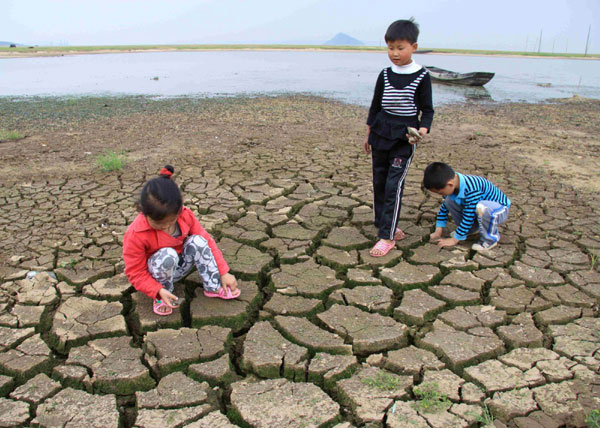Latest News
Poor water management adds pain to dry spell
(Xinhua)
Updated: 2011-05-31 17:16
 |
Large Medium Small |
Shrinking lakes and rivers
Standing in the luxuriant weeds, one would have never imagined that the location is the center of the Poyang Lake, China's largest freshwater lake in Jiangxi province.
Government data shows, due to the dry spell, the water level in the lake has dropped by nearly seven meters year-on-year and its water surface area has shrunk to less than one-third of normal years.
|
 Children play in the dried-up bottom of the Poyang Lake district in Duchang county of Jiujiang city, East China's Jiangxi province, May 25, 2011. [Photo/Xinhua] |
Lakes play a pivotal role in mitigating both droughts and floods, as they can be used to accommodate water during the flood season and to discharge water during the drought.
In fact, China's lakes, including the Poyang Lake, have been steadily contracting for decades under the effects of climate changes and human activities, according to Chen Lei, Minister of Water Resources.
Once having 3,000 natural lakes, China has lost about 1,000 of these lakes during the past 50 years, which was partly caused by a massive campaign of "farmland reclamation from lakes" in the densely-populated Yangtze River basin beginning in the 1950s. The reclamation was halted in the 1990s by the central government due to environmental concerns.
In recent years, some areas are still creating new land by filling in lakes so they might build homes, driven by skyrocketing real estate prices.
Similarly, some rivers in the drought-stricken areas also fail to provide water for emergency uses.
Due to the absence of dredging operations, the riverbeds of some streams have risen greatly, which leads to a decline in their capacities to hold water.
In addition, some hydropower stations have choked off rivers, as when downstream areas are in dire need of water, the stations on the upper stream intercept water to generate electricity.
Lack of labor and money
Due to the dry weather, Fang Shunxiao, a 61-year-old farmer in the township of Bianhe in Jianli county, missed the time to transplant rice seedlings and lost about 1,500 yuan.
Fang and his wife, with a granddaughter to feed, live on a paddy field measuring 0.7 hectare, as their children have been working away from home for long.
The riverbed of a five-meter-deep stream running by Fang's home has risen by two meters.
"The river was dug about 40 years ago. As far as I can remember, it was dredged only three times, all before 1990s," Fang said.
Labor force shortages partly impeded the development of rural water conservancy, said Li Xingzhong, head of the agriculture bureau in Jianli county.
Nearly 600,000 young people of the county's 1.5 million residents have sought jobs outside their hometown, Li said.
"Most of them are working in electronics factories in southern Guangdong province. Some others joined textile companies in eastern Zhejiang province," said Luo Bilian, Fang's neighbor.
A lack of investment is another problem, according to Xu Zhilong, deputy head of the county's water resources bureau.
"We've planned to build nine sets of culverts and sluices to divert water in the future in response to the drought. But the budget is unbearably huge for the county's finance," Xu said.
From 2011 to 2020, China's investment in water conservancy projects is expected to reach 4 trillion yuan, almost four times as much as that spent during the past 10 years, Chen Lei said earlier this month at a national work conference held in Changchun, capital city of northeastern Jilin province.
The investment will be used in projects, including consolidating 15,900 small reservoirs by 2013 and another 2,721 large and medium-sized reservoirs by 2015, Chen said, adding that the move was aimed at strengthening China's water conservancy capacities in fighting droughts and floods, which in recent years have frequently plagued the country.
| 分享按钮 |